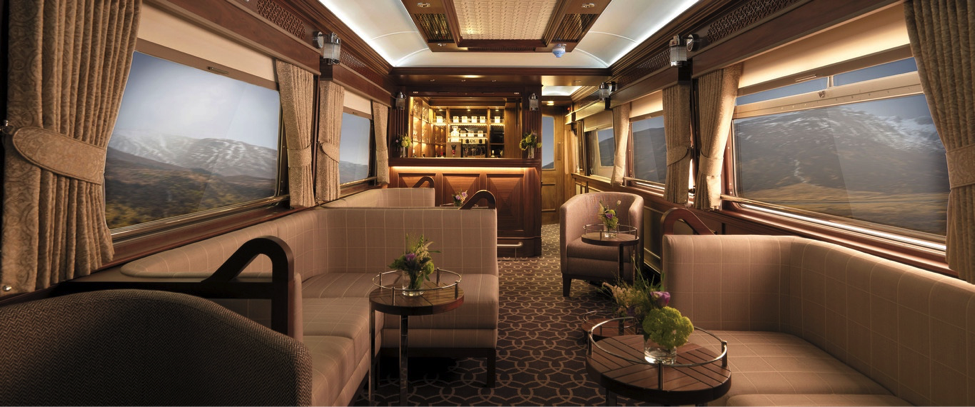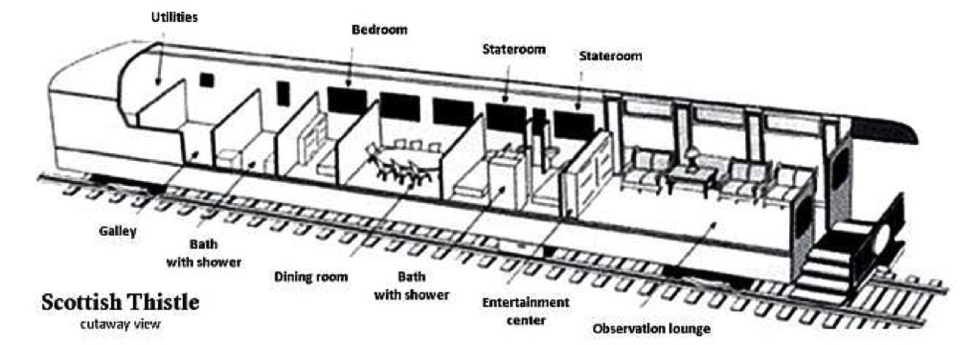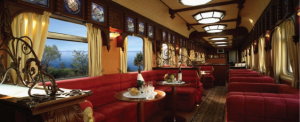
Although trains can sometimes be seen as a more antiquated form of travel, the fact is that millions of Americans ride the rails every year. Amtrak, the largest railroad company in the country, estimates that roughly 87,000 people use their trains daily.
However, while most Americans are used to sitting next to strangers and dealing with cramped luggage compartments, a select few get to ride a more dignified way – by private railcar. In this article, we’re going to discuss the ins and outs of personal railroad travel in the United States. If you’ve ever dreamed of having complete privacy on a train, these cars are unlike anything you’ve experienced before.
The Basics of Private Rail Travel
If we could take a time machine back to the golden days of railroad travel, private cars were more common than they are today. There are a few dozen in operation currently, although the people and organizations who own them don’t get to make the rules about how they run.
As the only railroad with passenger trains, Amtrak is the law for private car owners. Since these cars don’t have any means to power themselves, owners have to rely on Amtrak to pick them up and drop them off.
There are two ways a private car can travel. First, it can get hooked up to the back of a regular passenger train. In this case, up to two cars can be attached – no more. Usually, when that does happen, both cars are owned by the same person or organization, but not always.
The second option is to have a charter train. This is a train consisting solely of private railcars, and it can operate on all Amtrak rails that are “in-network.” Up until 2018, charter trains could run on smaller tracks and freight-only tracks, but Amtrak changed their rules arbitrarily, making it harder for charter trains to operate. We’ll get more into that relationship later.
Beyond the two travel methods, there are many unique challenges and costs associated with private railcar ownership.
Pick Up and Drop Off Locations
Since the person who owns the railcar gets to decide where to travel, they usually want a station more secluded than the ones offered for regular passengers. However, because Amtrak has to make the extra trip, it limits where private cars can sit overnight. Called “access points,” private railcar owners have to pay extra for the privilege of getting hitched to the train.
Monthly Rental Costs
Although an individual or organization can own a private railcar itself, it doesn’t own the track or the station where it resides. Again, these owners have to pay Amtrak to hold the car, much like paying a marina owner to keep your boat docked. However, unlike a ship, these costs can be much higher, ranging to almost two thousand dollars a month. These fees don’t even include maintenance and upkeep, which can be quite expensive for older cars that need a lot of refurbishing and upgrading.
Pay-Per-Mile Costs
Some private car owners like to take their property out for short day trips, but others prefer to go on longer, overnight journeys. Regardless of the distance, Amtrak currently charges $3.74 per mile. So, going from New York to Washington can add up, and that’s not including the overnight fees for staying at a stop temporarily. In most cases, a car owner can spend several thousand dollars on transportation expenses, all without accounting for on-board staff, including porters and chefs.
Cheap Up-Front Costs, Expensive Renovation
At first glance, owning a private car can look relatively affordable. Depending on the make and model of the car, as well as its current condition, the whole thing might set you back only a few thousand bucks. However, while the upfront price may be low, that’s barely the tip of the iceberg.
Most owners will sink hundreds of thousands of dollars into refurbishment and renovation. While each car is different, it’s not uncommon to spend at least $250,000 to get the car up to standards. In most cases, the interior is made to resemble what luxury railcars would look like during the glory days of railroad travel. Everything is designed to maintain a certain aesthetic, such as deep-colored wood, timeless upholstery and drapes, and antique lighting fixtures.
Once you add in the rental fees, travel fees, and maintenance fees, owning a private railcar is not for the faint of heart. However, this hobby attracts more than just the super-rich. Many of these owners are hobbyists with a deep love of the railroad. Additionally, historical societies and railroad organizations purchase and refurbish private cars to use as “living museums.”
The American Association of Private Railroad Car Owners, Inc.
Because there are so few private owners in the country (roughly 80 or so), it’s not hard for them to stay organized. AAPRCO not only helps these owners get in touch with each other, but it owns a few cars itself and hosts an annual convention. Every year, members will create a charter train of their railcars and travel cross-country. For them, it’s not about the destination, but the journey itself.
Benefits of Traveling Privately By Rail
For many people, the high costs of ownership and maintenance are nowhere near enough to justify getting a private railcar. However, for those in AAPRCO, the price isn’t even an issue. Yes, these cars are expensive, but the value they provide is much higher. As owner DeWhitte Chapple remarked at the 2019 convention, “To love a train is a defective gene, but it’s one that a lot of us here have.”
Chapple himself owns several cars, although he purchased some of them with others to help share the financial burden. When you talk to these owners about the reason behind their decision, it becomes clear that the benefits outweigh the costs, no matter how high they are. These benefits include:

Comfortable Accommodations
When riding in a modern passenger car, you’ll often be fighting for an armrest or a place to put your luggage. Even if you’re on a daily commuter train, the accommodations leave a lot to be desired. Trains these days are about getting you to the destination quickly, not making you comfortable along the way.
Depending on which Amtrak train you’re on, it can fit hundreds of passengers. For example, the California Zephyr holds up to 294 people, while the Auto Train can fit up to 500. In a private car, however, most of them carry 50 individuals or less. Those that have overnight cabins generally hold around 25 max.
So, rather than throwing elbows and having to deal with sleeping neighbors, you get to stretch your feet out and relax in style. Plus, the old-fashioned decor and ambiance make the trip even more enjoyable.
Even the food in a private railcar is better, provided that you pay for the luxury. Imagine having a chef cook fresh meals for you right in the car. No more bagged lunches or food from a deli fridge – everything is made to order, just the way you like it.
Personal Freedom
Yes, traveling from one place to the next via plane is going to be much faster. A trip from coast to coast can take just a few hours, while it will take several days on a train. However, speed is the last reason to take a private railcar.
According to some owners, the freedom offered by these cars is second to none. At the airport, you have to deal with security checkpoints, luggage restrictions, and pushy airline attendants. On a private railcar, you have total control over everything that goes on inside.
A Unique Travel Experience
Because railroads are a unique network of pathways, you get access to views that you can’t get any other way. Many rails are not alongside roads and highways, meaning that you can’t replicate the experience in a car or bus ride.
To help improve the visual experience, some private railcars are outfitted with massive dome windows. This way, passengers get to see the environment in 360 degrees. Depending on where you’re going, these vistas are breathtakingly gorgeous.
Another element that makes these trips more enjoyable is that you can bring your friends and family along. Many owners will rent out their cars regularly to help cover costs, but a lot of the time, they use the opportunity to have a more intimate travel experience with their loved ones. Unlike a road trip or a plane ride, sitting in a railcar allows passengers to sit and interact along the way. So, even though the journey may take longer, it’s not like you’re sitting still the whole time, trying to evade boredom.
Camaraderie and Brotherhood
Finally, being a private railcar owner means that you are part of an exclusive club. As we mentioned, only a handful of individuals own these cars, making it more unique than most other travel-related groups.
Also, because you have to have a deep affection for railroad history and culture to own one of these cars, meeting other enthusiasts is always a treat. During the annual AAPRCO conventions, owners love the kinship created among the group. While the charter train is en route, members will have impromptu parties and regale each other with stories and banter.
Owning vs. Renting a Private Rail Car
Fortunately, if you like the idea of riding in a private car but don’t want the financial burden of owning one, rentals are quite common. In fact, many owners will subsidize their hobby by renting their cars out to various groups and organizations. Even AAPRCO helps facilitate rentals, hosting guests on its own cars or supplementing them out to various members.
If you are interested in renting a private car, you’ll likely need to be part of a larger group. It’s not exactly cost-effective to hire staff and pay travel fees for just one person. However, there are many situations where private railcars prove viable, for example:
-Historical Society Trips – If the society owns the car, it will usually organize a trip for both new and old members. These journeys are an easy way to share the history of the railroad in a fun and exciting way.
-VIP Travel – Typically, it’s heads of state who like to ride the rails privately. Every president from Carter to Obama has traveled on the famous Georgia 300 car, initially built in 1930. Besides presidents, some high-level celebrities like Michael Jackson and other bands have ridden privately over the years.
-Business Groups – While renting a private car isn’t necessarily cost-effective for a company, it can offer executives a quiet place to converse and work together during the trip. For example, a private railcar could work well for a corporate retreat.

The Future of Private Rail – A Subculture in Danger
Because Amtrak is the only operator that can transport private railcars, owners have little recourse when the company makes a change. Also, since Amtrak is partially funded through government subsidies (thanks to a Nixon-era law), it feels increased pressure to make money.
Interestingly, private car owners are highly profitable, but only if you look at them individually, not as part of a much larger organization. Annually, Amtrak makes roughly four million dollars from private ownership fees. However, all told, the company earns over three billion from standard ticket sales.
Because of this discrepancy, Amtrak cut travel options for private railcars back in 2018. With only a few week’s notice, the company said that private cars could only be used on tracks “in-network” and that the cost per mile would go up by 12 percent. Also, cross-country trips, which are usually operated at a loss by the company, would be forbidden unless done at least three times annually. Even AAPRCO only hosts two cross-country charters every year, so this change disrupted the industry significantly.
Another piece of the puzzle is the fact that Amtrak is trying to speed up its trains. The U.S. falls well behind other countries that have trains that can get up to 500 miles per hour. According to U.S. law, private cars can only go as fast as 110 miles per hour. If Amtrak does move forward with upgrading its trains, private owners could see their travel options reduced even more.
Overall, private rail travel is a piece of American history, and we would hate to see it disappear forever. Fortunately, owners and the AAPRCO are fighting fiercely to preserve the tradition – we’ll just have to see how it all plays out.
Resources:
https://en.wikipedia.org/wiki/Amtrak
http://www.aaprco.com/wp-content/uploads/2020/05/aaprco-15may2020.pdf
https://www.luxurytrainclub.com/trains/private-rail-cars/

